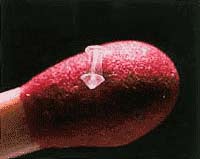 Dry eye is a common condition that occurs when the eyes do not produce enough tears to keep the eye moist and comfortable (read more). When relief from dry eye is not achieved by using artificial tears or other lubricating products, Dr. Seibel often recommends punctal plugs or permanent occlusion. These are relatively simple procedures performed with local anesthesia.
Dry eye is a common condition that occurs when the eyes do not produce enough tears to keep the eye moist and comfortable (read more). When relief from dry eye is not achieved by using artificial tears or other lubricating products, Dr. Seibel often recommends punctal plugs or permanent occlusion. These are relatively simple procedures performed with local anesthesia.
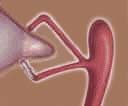 One way to alleviate dry eye is to help the eyes to make longer use of whatever amount of naturally lubricating tears they do produce or that are added artificially (eye drops). This is best accomplished by closing off the small funnel-like drain hole found in the inner corner of the upper and lower eyelids.
One way to alleviate dry eye is to help the eyes to make longer use of whatever amount of naturally lubricating tears they do produce or that are added artificially (eye drops). This is best accomplished by closing off the small funnel-like drain hole found in the inner corner of the upper and lower eyelids.
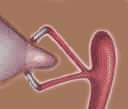 This drain hole, called a punctum, may be closed with a tiny plug called a punctal plug or permanently closed with a cauterizing heat or electrical procedure. The punctum are typically closed in only the lower ducts of both eyes, and only occasionally in all four ducts, top and bottom.
This drain hole, called a punctum, may be closed with a tiny plug called a punctal plug or permanently closed with a cauterizing heat or electrical procedure. The punctum are typically closed in only the lower ducts of both eyes, and only occasionally in all four ducts, top and bottom.
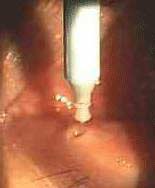 Punctal plugs can be temporary or semi-permanent. Temporary plugs dissolve a few days after insertion. They are typically used to determine the effectiveness of plugging the punctum. If the temporary plugs provided the needed relief from dry eye, then semi-permanent plugs made of silicone can be used as replacements. The semi-permanent plugs are non-dissolving and may be removed in the future if desired or necessary, such as in the case of some patients who may find the semi-permanent plugs to be irritating due to the edge of their cap rubbing against the eye. For this reason patients may prefer long-acting dissolvable plugs that are inserted into the puncture without a cap protruding. These plugs can be placed in Dr. Seibel’s office with eyedrops anesthesia.
Punctal plugs can be temporary or semi-permanent. Temporary plugs dissolve a few days after insertion. They are typically used to determine the effectiveness of plugging the punctum. If the temporary plugs provided the needed relief from dry eye, then semi-permanent plugs made of silicone can be used as replacements. The semi-permanent plugs are non-dissolving and may be removed in the future if desired or necessary, such as in the case of some patients who may find the semi-permanent plugs to be irritating due to the edge of their cap rubbing against the eye. For this reason patients may prefer long-acting dissolvable plugs that are inserted into the puncture without a cap protruding. These plugs can be placed in Dr. Seibel’s office with eyedrops anesthesia.
Punctal occlusion by electrocautery is a permanent (irreversible) alternative to plugs. Should your dry eye symptoms disappear after the temporary plugs are inserted, you and Dr. Seibel may want to consider permanent punctal occlusion. If permanent punctal occlusion is considered desirable, the methods most widely used and most effective in producing permanent closure are:
Very occasionally, permanent occlusion may need to be repeated in order to be fully effective.
Plug insertion is performed in an examination room; it does not require a surgery center. Once you have been checked in and settled comfortably, drops will be used to numb your eye; no injections are needed.
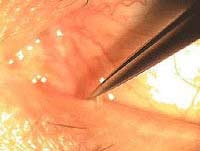 Dr. Seibel will gently pull your eyelid up and ask you to look toward the outside of your head, away from your nose. If plugs are being inserted, a forceps-like applicator will be used to place one into the corner of your eye. A different applicator will then be used to gently push the plug into the opening and you’ll be asked to blink. Once the plugs get wet, they will expand to completely fill the opening. The entire procedure takes only a few minutes.
Dr. Seibel will gently pull your eyelid up and ask you to look toward the outside of your head, away from your nose. If plugs are being inserted, a forceps-like applicator will be used to place one into the corner of your eye. A different applicator will then be used to gently push the plug into the opening and you’ll be asked to blink. Once the plugs get wet, they will expand to completely fill the opening. The entire procedure takes only a few minutes.
The procedure is basically the same for permanent occlusion, only a device is used to seal off (cauterize) the opening and nothing is inserted.
Many patients report immediate relief from dry eye symptoms and resume normal activities immediately. Serious complications with punctal occlusion are extremely rare, but like any medical procedure, it does have some risks. If you experience any discomfort with the semi-permanent plugs, Dr. Seibel can easily remove them.
At Seibel Vision Surgery, your eyes and vision are of paramount importance. To help you make the most informed decisions regarding the welfare of your vision, we are delighted to be of service and are happy to answer any questions you may have.
Please take the time to familiarize yourself with the information contained on this site. We have compiled it especially for you!
Monday, Tuesday, Wednesday, and Thursday
8:30 a.m. to 3:30 p.m.
Friday
8:30 a.m. to 3:00 p.m.
OUR ADDRESS
11620 Wilshire Boulevard, Suite 711
Los Angeles, California 90025
PHONE
(310) 444-1134
FAX
(310) 444-1130
Learn about cataracts and their treatment
Learn more about CataractsGlaucoma, Macular Degeneration,
Medical Eye Exams, and other